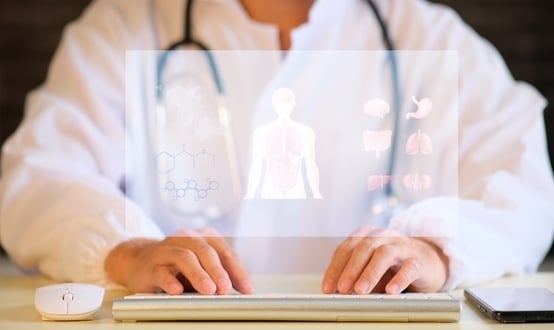Predictions for the year ahead: UK digital health leaders on 2017
- 3 January 2017

With dozens of digital plans, that 'paperless 2020' goal looming ever closer, and increasing cyber security threats, 2017 should busy year on the digital health front. In the second of two-part look ahead at 2017, Digital Health News ask some of the UK’s healthcare IT leaders for their predictions.
On cybersecurity

Rob Shaw, chief operating officer, NHS Digital
A big focus for NHS Digital in 2017 is to support health and care organisations to keep their data safe and secure – whether it’s stored digitally or on paper. We will be offering practical support, advice, policies and guidance to protect information in an increasingly digital system.
In 2017, we will be: increasing our monitoring of threats; helping organisations move off unsupported systems; assessing NHS organisations against the National Data Guardian’s cyber security standards; and offering help for organisations that have experienced a cyber security incident.
But what is going to make the real difference in reducing the risk of data security incidents in the NHS? It’s our people. Some of the most important work we will be doing this year is refreshing the IG Toolkit, making it work for both paper and digital information assurance; reducing administrative burden; and encouraging the reporting of near misses. We will also be rolling out new training modules for staff, so that we know everyone understands how to keep information safe.
In 2017, we won’t prevent every cyber security incidents in the NHS, but we will be better placed to protect ourselves, making these incidents less likely to succeed and allowing us to act quickly to limit any issues.
To relieve pressure on frontline services we will provide the networks and technology needed for community pharmacy to offer NHS services for common ailments, emergency medicines and discharge medication reviews.
On data and analytics

Rachel Dunscombe, chief information officer, Salford Royal NHS Foundation Trust
I think in 2017 we are going to start seeing developments that change patients’ pathways, based on what we already know about them. We’re going to start leveraging the data to make clinical decisions, using it not just decision support but for choices about pathways.
We have buckets of data in the NHS but we do very little with it, in terms of direct care. The introduction of SNOMED will help improve how this data can be used to influence patient care.
We already do a lot of a work in this space, as do other organisations, around acute kidney injury and sepsis. For now, these data driven tools only flag up a person’s score, but in 2017 we are hoping it will recommend actions to take based on that score.
This tools will be also be informed by a wider range of data. For instance, with our rheumatology pain score we will be looking at the weather and how that influences the efficacy of medication. This is not going to be on masse in 2017 but it will become real for some patients.
But it is going to be a ten-year journey. Up until now, a lot of this stuff has been conceptual but we’re starting to do the early work, moving off the hype curve into reality.
On usability

Andy Williams, chief executive, NHS Digital
In 2017, NHS Digital’s focus will be on supporting local NHS organisations to bring together their expertise to initiate digital change.
We are recruiting to expand our team of clinical experts for 2017, which is crucial in designing systems that help frontline staff to deliver better patient care.
IT experts talk a lot about systems being ‘secure by design’ and we also want our systems to be ‘clinically assured by design’. That doesn’t just mean working with our own clinicians, but engaging with the sector so that our technology responds to real issues on the frontline, while being easy and intuitive to use.
One example of this underway is work on providing mobile access to the NHS Spine, which will help community teams and staff moving between patients on wards work smarter and faster. Clinicians have told us how frustrating it was to start from scratch every time they log-in, so session persistence allows staff to remove their smartcard from the reader, and to put it back in without losing their place in the system.
We need to support clinical and technological system leaders to work more closely together across the NHS if we are to achieve our aims. We already have a strong CIO and CCIO network and in 2017 we want to offer further support to encourage technicians, clinicians and the private sector to come together. It is this collaboration that will bring true innovation and creativity.
On Ireland

Richard Corbridge, chief executive, eHealth Ireland
In the last two years, the Irish healthcare system has made great strides in closing the digital health gap. The aim in 2017 is to continue this progress, laying foundations for the leap that the digital agenda can bring to healthcare.
In 2017, we will be implementing the first electronic health record in every maternity hospital in Ireland. This integrated solution to all parts of the care pathway, offers early warning systems for illness. Using IoT (internet of things) devices to track and alert clinicians to risks brings a new level of safety and efficiency for the patient.
Access to a summary care record with lists of medications dispensed in the community will start to reduce clinical risks for patients in 2017 as they move from care setting to care setting. Opportunity to capture hospital-derived scripts electronically under a wider ePrescribing initiative will provide a wealth of data not seen before in the Irish healthcare system.
The new laboratory systems programme will, in 2017, provide a central database, a single data store for orders and test results.
The delivery of Ireland’s first patient portal is also fundamental to delivering contextualised patient care. This new and innovative process allows patients to be truly at the centre of their care, allowing them to view who has accessed their records.
The quest to bring digital to the heart of the public agenda will continue in 2017. Engagement with a wider variety of stakeholders through events such as Dublin Tech Summit and embracing conversations with the public, through new routes, will shine a light on the benefits for all in creating digital integrated care.
On Wales

Andrew Griffiths, director, NHS Wales Informatics Service
In 2017, we will continue to work with the Welsh NHS to create and sustain a single integrated digital platform to support the delivery of health and social care. This will include the Welsh Community Care Information System, which will enable the sharing of relevant and appropriate information between health and social care.
There will be a more advanced version of the Welsh Clinical Portal, the digital workspace for hospital doctors. It will provide doctors with the essential information they need to begin treatment ‘the letters, the images and the results’. It will further streamline daily tasks to support patient care, including medicines transcribing, end-to-end e-referrals and instant access to diagnostic reports, allowing pathology results, radiology reports and images to be viewed across geographical and organisational boundaries. GPs will also benefit from access to test results taken outside their organisational boundaries.
Primary care will see new national services including use of Cloud 365 services, GP2GP medical record transfers and increased use of text messaging to remind patients of appointments and clinics.
On interoperability

Beverley Bryant, digital transformation director, NHS Digital
Interoperability might not make for the most obvious new year message, but it’s all about bringing people together and sharing knowledge, so that we can give patients better care. That feels worthy of celebration to me.
We have big plans for digital in the NHS and believe that technology has the power to transform patient care. But to do that we need to have the right building blocks in place – we need NHS systems to talk to each other so that data can flow for direct patient care, giving patients a seamless experience.
If you interact with any big company, you don’t expect to have to resupply all your information every time you contact them, so why, when it comes to the NHS, do we accept providing the same details, to multiple providers, all of whom then code and store that data and have different bits of our medical information at hand when they see us?
Last year we spent a lot of time working on developing shared coding and operability standards. 2017 is the year when this work comes to life to support patient care.
We will be launching the GP Connect pilot by the end of the year, with records being securely shared between GP practices in Leeds, and those in the NHS Kernow region. This project has taken longer than anticipated to deliver, but this is because we know how important it is to get this right.
Initially this will allow GPs to view patient records across systems, but the next step is for this to be used to enable patients to be able to book GP appointments anywhere in their area.
On patients and wearables

Adrian Byrne, director of informatics, University Hospitals Southampton NHS Foundation Trust
For me, 2016 was such a predictable year. Just about everything newsworthy could have been foreseen by the most amateur of astrologers. I am therefore hoping for more surprises in 2017.
Really, speaking from Southampton’s perspective, we have been trying to demonstrate to the world that secondary care can really benefit from an online relationship with patients, whilst also enhancing their experience. We believe that we have achieved this, and the fact that we won a couple of awards at EHI and HSJ respectively makes me think that we are getting somewhere in terms of demonstrating that success.
Therefore, I would like to think that 2017 will be the year when this kind of activity moves into the mainstream and becomes business as usual for some, while sustainability and transformation plans will help layout a roadmap to achieves this for others.
I would also like to see more automated data entry through attached and wearable devices. It seems strange that most people now seem to have some technical jewellery hanging off their wrist but we still largely transcribe heart rate readings from a machine into a system (or paper). I’m hoping we start to see that paper as more the exception than the norm.
Finally, there has been a lot of hype around interoperability and FHIR in the last couple of years. I sit on the Code4Health community interoperability board, and I’d like to think that, with the help of TechUK and INTEROPen we can start to demonstrate standard open platform integration at scale.




